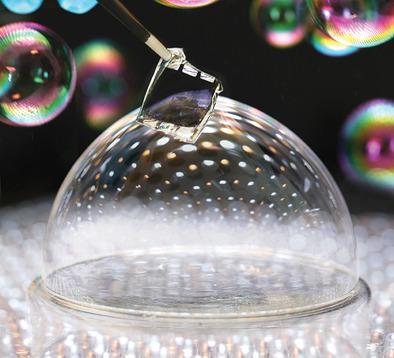当前位置:
X-MOL 学术
›
Adv. Mater. Technol.
›
论文详情
Our official English website, www.x-mol.net, welcomes your
feedback! (Note: you will need to create a separate account there.)
Fully Inkjet‐Printed, Ultrathin and Conformable Organic Photovoltaics as Power Source Based on Cross‐Linked PEDOT:PSS Electrodes
Advanced Materials Technologies ( IF 6.4 ) Pub Date : 2020-06-14 , DOI: 10.1002/admt.202000226 Eloïse Bihar 1, 2 , Daniel Corzo 1 , Tania C. Hidalgo 3 , Diego Rosas‐Villalva 1 , Khaled N. Salama 2 , Sahika Inal 3 , Derya Baran 1
Advanced Materials Technologies ( IF 6.4 ) Pub Date : 2020-06-14 , DOI: 10.1002/admt.202000226 Eloïse Bihar 1, 2 , Daniel Corzo 1 , Tania C. Hidalgo 3 , Diego Rosas‐Villalva 1 , Khaled N. Salama 2 , Sahika Inal 3 , Derya Baran 1
Affiliation

|
Ultra‐lightweight solar cells have attracted enormous attention due to their ultra‐conformability, flexibility, and compatibility with applications including electronic skin or miniaturized electronics for biological applications. With the latest advancements in printing technologies, printing ultrathin electronics is becoming now a reality. This work offers an easy path to fabricate indium tin oxide (ITO)‐free ultra‐lightweight organic solar cells through inkjet‐printing while preserving high efficiencies. A method consisting of the modification of a poly(3,4‐ethylenedioxythiophene) polystyrene sulfonate (PEDOT:PSS) ink with a methoxysilane‐based cross‐linker (3‐glycidyloxypropyl)trimethoxysilane (GOPS)) is presented to chemically modify the structure of the electrode layer. Combined with plasma and solvent post‐treatments, this approach prevents shunts and ensures precise patterning of solar cells. By using poly(3‐hexylthiophene) along rhodanine‐benzothiadiazole‐coupled indacenodithiophene (P3HT:O‐IDTBR), the power conversion efficiency (PCE) of the fully printed solar cells is boosted up to 4.73% and fill factors approaching 65%. All inkjet‐printed ultrathin solar cells on a 1.7 µm thick biocompatible parylene substrate are fabricated with PCE reaching up to 3.6% and high power‐per‐weight values of 6.3 W g−1. After encapsulation, the cells retain their performance after being exposed for 6 h to aqueous environments such as water, seawater, or phosphate buffered saline, paving the way for their integration in more complex circuits for biological systems.
中文翻译:

基于交联的PEDOT:PSS电极的完全喷墨印刷,超薄且适形的有机光伏电源
超轻型太阳能电池因其超适形性,灵活性和与生物皮肤应用或小型电子设备等应用的兼容性而备受关注。随着印刷技术的最新发展,印刷超薄电子产品已成为现实。这项工作为在保持高效率的同时通过喷墨印刷制造不含铟锡氧化物(ITO)的超轻型有机太阳能电池提供了一条简便的途径。提出了一种用基于甲氧基硅烷的交联剂(3-缩水甘油基氧基丙基)三甲氧基硅烷(GOPS)改性聚(3,4-乙烯二氧噻吩)聚苯乙烯磺酸酯(PEDOT:PSS)油墨的方法,以化学方式改性电极层。结合等离子体和溶剂后处理,这种方法可防止分流并确保太阳能电池的精确图案化。通过将聚(3-己基噻吩)与若丹宁-苯并噻二唑偶联的茚并二噻吩(P3HT:O-IDTBR)一起使用,完全印刷的太阳能电池的功率转换效率(PCE)可提高至4.73%,填充系数接近65%。所有在1.7 µm厚的生物相容性聚对二甲苯衬底上进行喷墨打印的超薄太阳能电池均采用PCE制成,可达到3.6%的高功率和6.3 W g的高单位重量重量值-1。封装后,细胞在暴露于水,海水或磷酸盐缓冲盐水等水性环境6小时后仍能保持其性能,从而为整合到生物系统的更复杂回路中铺平了道路。
更新日期:2020-08-10
中文翻译:

基于交联的PEDOT:PSS电极的完全喷墨印刷,超薄且适形的有机光伏电源
超轻型太阳能电池因其超适形性,灵活性和与生物皮肤应用或小型电子设备等应用的兼容性而备受关注。随着印刷技术的最新发展,印刷超薄电子产品已成为现实。这项工作为在保持高效率的同时通过喷墨印刷制造不含铟锡氧化物(ITO)的超轻型有机太阳能电池提供了一条简便的途径。提出了一种用基于甲氧基硅烷的交联剂(3-缩水甘油基氧基丙基)三甲氧基硅烷(GOPS)改性聚(3,4-乙烯二氧噻吩)聚苯乙烯磺酸酯(PEDOT:PSS)油墨的方法,以化学方式改性电极层。结合等离子体和溶剂后处理,这种方法可防止分流并确保太阳能电池的精确图案化。通过将聚(3-己基噻吩)与若丹宁-苯并噻二唑偶联的茚并二噻吩(P3HT:O-IDTBR)一起使用,完全印刷的太阳能电池的功率转换效率(PCE)可提高至4.73%,填充系数接近65%。所有在1.7 µm厚的生物相容性聚对二甲苯衬底上进行喷墨打印的超薄太阳能电池均采用PCE制成,可达到3.6%的高功率和6.3 W g的高单位重量重量值-1。封装后,细胞在暴露于水,海水或磷酸盐缓冲盐水等水性环境6小时后仍能保持其性能,从而为整合到生物系统的更复杂回路中铺平了道路。











































 京公网安备 11010802027423号
京公网安备 11010802027423号